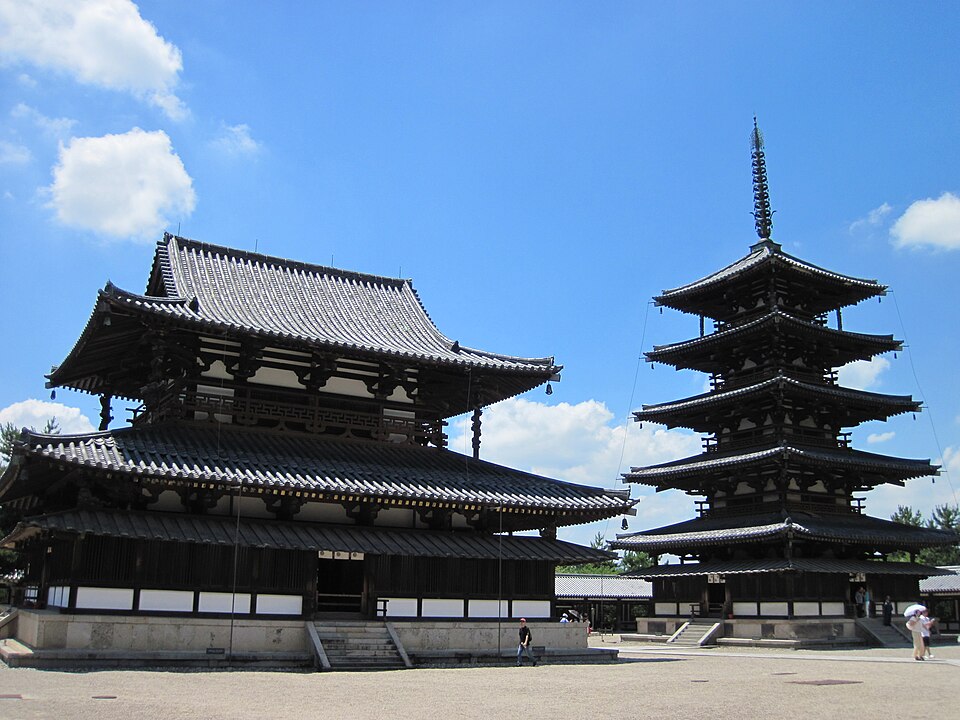Introduction: The Allure of a Millennium-Old Sanctuary
Horyuji Temple (法隆寺, Hōryūji) stands as one of Japan’s oldest temples and home to the world’s oldest surviving wooden structures. Founded in 607 AD, this Buddhist sanctuary not only witnessed the rise of Buddhism in Japan but also stands as a testament to human architectural artistry. This guide will take you through this UNESCO World Heritage site, exploring its millennial legacy.
Key Information at a Glance
- Founded: 607 AD
- Founder: Prince Shotoku
- Location: Ikaruga, Nara Prefecture, Japan
- Main Feature: World’s oldest wooden building complex
- UNESCO World Heritage Site: Designated in 1993
Rich History: A Testament to Buddhism and Architecture
Horyuji Temple, founded by Prince Shotoku in 607 AD, is a crucial witness to the early development of Buddhism in Japan. Having weathered over 1,400 years of history, its wooden structures have miraculously survived, providing invaluable insight into ancient East Asian architectural techniques. Horyuji is not just a temple; it’s a living textbook of architectural history, showcasing the evolution from the Asuka period (538-710 AD) to the present day.
Main Attractions in Detail
Western Precinct (Saiin Garan)
The Western Precinct is Horyuji’s oldest and most important building complex. Enclosed by roofed corridors, it houses the world’s oldest wooden structures. The central gate (Chumon), main hall (Kondo), and five-story pagoda form a unique “one pagoda, one main hall” layout, rare in Japanese temple architecture.
The main hall houses Japan’s oldest surviving Buddhist statues, reflecting the artistic characteristics of the Asuka period. The five-story pagoda, standing 55.6 meters tall, is Japan’s oldest existing five-story pagoda, showcasing exquisite architectural techniques. Although the pagoda’s interior murals are no longer open to the public, their historical value is immeasurable.
The corridors of the Western Precinct display numerous national treasure-class artifacts, including ancient paintings, Buddhist statues, and architectural components, offering visitors an excellent opportunity to understand ancient Japanese art.
Eastern Precinct (Toin Garan)
Located on the eastern side of the temple grounds, the Eastern Precinct’s core building is the octagonal Yumedono (Hall of Visions). Built in 739 AD to commemorate Prince Shotoku, it houses a life-sized statue of the prince surrounded by Buddha statues and various monk sculptures. The unique octagonal design of Yumedono is rare in Japanese temple architecture, reflecting the influence of Tang Dynasty architecture on Japan.
Other buildings in the Eastern Precinct include the Nabaido (Sutra Hall), To-in (Eastern Temple), Shoro (Bell Tower), and more. Although smaller in scale than the Western Precinct, these structures are equally valuable in terms of architecture and art.
Gallery of Temple Treasures
Built in 1998 between the Western and Eastern Precincts, the Gallery of Temple Treasures was designed to exhibit Horyuji’s vast collection of art. The gallery displays Buddhist statues, relics, paintings, and other artifacts from various periods, providing a comprehensive overview of Japanese Buddhist art history. The gallery building itself is an excellent example of modern architecture blending with traditional temple style.
Chuguji Temple
Although a separate temple, Chuguji is closely related to Horyuji and located just behind Horyuji’s Eastern Precinct. Chuguji is renowned for its main object of worship – a beautifully carved statue of a sitting Buddha with a gentle smile. This statue is a masterpiece of Japanese Buddhist sculpture. Note that a separate ticket is required for entry to Chuguji Temple.
Best Time to Visit
Horyuji Temple is beautiful year-round, but spring (March-May) and autumn (October-November) are particularly stunning. Spring offers cherry blossoms in full bloom, while autumn presents vibrant fall foliage. Additionally, the annual Shunie ceremony on February 22nd is Horyuji’s most important religious event, offering a unique spiritual atmosphere.
Getting There
From central Nara, you can reach Horyuji Temple by:
- JR Yamatoji Line:
- Take the JR Yamatoji Line from JR Nara Station to Horyuji Station (about 12 minutes, 230 yen)
- From Horyuji Station, walk for 20 minutes or take bus number 72 to Horyuji Temple (about 5 minutes, 190 yen)
- Direct Bus:
- Take bus number 98 from JR Nara Station or Kintetsu Nara Station directly to Horyuji-mae (about 60 minutes, 770 yen)
Opening Hours and Admission Fees
- Horyuji Temple:
- Hours: 8:00-17:00 (until 16:30 from early November to late February)
- Admission: 1500 yen
- Open year-round
- Chuguji Temple:
- Hours: 9:00-16:30 (until 16:00 from October to late March)
- Admission: 600 yen
- Open year-round
Visitor Tips and Advice
- Allow ample time: Plan at least half a day to explore Horyuji and Chuguji.
- Dress appropriately: As a religious site, modest clothing is appreciated.
- Photography restrictions: Some interiors prohibit photography. Please follow the rules.
- Consider a combo ticket: If planning to visit Chuguji, look for a combined ticket option.
- Audio guide: Available at the entrance for in-depth historical insights.
- Avoid crowds: Visit early in the morning or near closing time for a less crowded experience.
- Explore surroundings: Consider visiting nearby historical sites like Hokkiji Temple.
Official Websites
Conclusion
Horyuji Temple is not just a witness to Japanese Buddhist history; it’s a world cultural heritage treasure. Its wooden structures, with their long history and exquisite craftsmanship, tell stories from over a thousand years ago. Whether you’re an architecture enthusiast, a history researcher, or a casual tourist, Horyuji offers a cultural journey through time. When in Nara, don’t miss this millennia-old sanctuary that has witnessed the rise of Buddhism in Japan.
Plan your visit to Horyuji Temple today and experience the charm of the world’s oldest wooden buildings firsthand!
